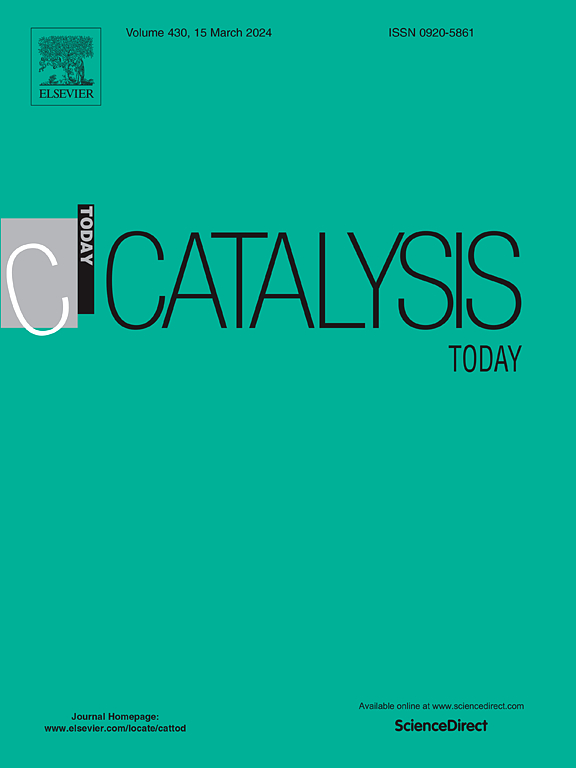Plasma–enhanced chemical vapor deposition of Co3O4 thin films as a new approach for improving oxygen evolution activity
IF 5.2
2区 化学
Q1 CHEMISTRY, APPLIED
引用次数: 0
Abstract
The development of efficient and durable electrocatalysts for the oxygen evolution reaction (OER) remains a key challenge in advancing sustainable energy technologies. Among cobalt – based materials, spinel Co3O4 is a widely studied catalyst; however, its bulk form often suffers from poor electrical conductivity and limited accessibility of active sites. In this study, we demonstrate that plasma–enhanced chemical vapor deposition (PECVD), followed by thermal annealing in air, provides an effective route for vacancy engineering in CoxOy thin films inducing both oxygen and cobalt vacancies without relying on foreign dopants or ion–exchange processes. The Co3O4 films demonstrated exceptional OER performance, with the best sample achieving a low overpotential of 343 mV at 10 mA cm–2, and a high capability for Co4+ formation, a key intermediate in the OER process. Additionally, the films exhibited catalytic activity not only at the surface, but also throughout their entire volume, highlighting the significance of deposition time and film thickness in optimizing OER performance. Ab–initio calculations, including Bader charge analysis and density of states evaluations, further elucidate the role of defect chemistry: oxygen vacancies enhance *OH adsorption and drive structural reconstruction, while cobalt vacancies reduce the energy barrier for deprotonation and facilitate the Co3+ → Co4+ oxidation process. Overall, this work establishes PECVD combined with thermal treatment as a powerful and scalable strategy for tailoring defect concentrations in cobalt oxide catalysts. The approach offers valuable insights into the rational design of high–performance OER catalysts, with broad implications for electrochemical energy conversion technologies.
等离子体增强化学气相沉积Co3O4薄膜作为提高析氧活性的新途径
为析氧反应(OER)开发高效耐用的电催化剂仍然是推进可持续能源技术的关键挑战。在钴基材料中,尖晶石Co3O4是一种广泛研究的催化剂;然而,它的体积形式往往受到导电性差和活性位点有限的可及性的影响。在这项研究中,我们证明了等离子体增强化学气相沉积(PECVD),然后在空气中进行热退火,为CoxOy薄膜的空位工程提供了一条有效的途径,可以在不依赖于外来掺杂剂或离子交换过程的情况下诱导氧和钴空位。Co3O4薄膜表现出优异的OER性能,最佳样品在10 mA cm-2下的过电位为343 mV,并且具有高的形成Co4+的能力,Co4+是OER过程中的关键中间体。此外,膜不仅在表面表现出催化活性,而且在整个体积中都表现出催化活性,这突出了沉积时间和膜厚度对优化OER性能的重要性。Ab-initio计算,包括Bader电荷分析和态密度评估,进一步阐明了缺陷化学的作用:氧空位增强*OH吸附并驱动结构重构,而钴空位降低脱质子能垒,促进Co3+→Co4+氧化过程。总的来说,这项工作建立了PECVD结合热处理作为一种强大的和可扩展的策略来调整钴氧化物催化剂中的缺陷浓度。该方法为高性能OER催化剂的合理设计提供了有价值的见解,对电化学能量转换技术具有广泛的意义。
本文章由计算机程序翻译,如有差异,请以英文原文为准。
求助全文
约1分钟内获得全文
求助全文
来源期刊

Catalysis Today
化学-工程:化工
CiteScore
11.50
自引率
3.80%
发文量
573
审稿时长
2.9 months
期刊介绍:
Catalysis Today focuses on the rapid publication of original invited papers devoted to currently important topics in catalysis and related subjects. The journal only publishes special issues (Proposing a Catalysis Today Special Issue), each of which is supervised by Guest Editors who recruit individual papers and oversee the peer review process. Catalysis Today offers researchers in the field of catalysis in-depth overviews of topical issues.
Both fundamental and applied aspects of catalysis are covered. Subjects such as catalysis of immobilized organometallic and biocatalytic systems are welcome. Subjects related to catalysis such as experimental techniques, adsorption, process technology, synthesis, in situ characterization, computational, theoretical modeling, imaging and others are included if there is a clear relationship to catalysis.
 求助内容:
求助内容: 应助结果提醒方式:
应助结果提醒方式:


